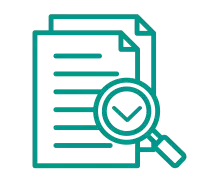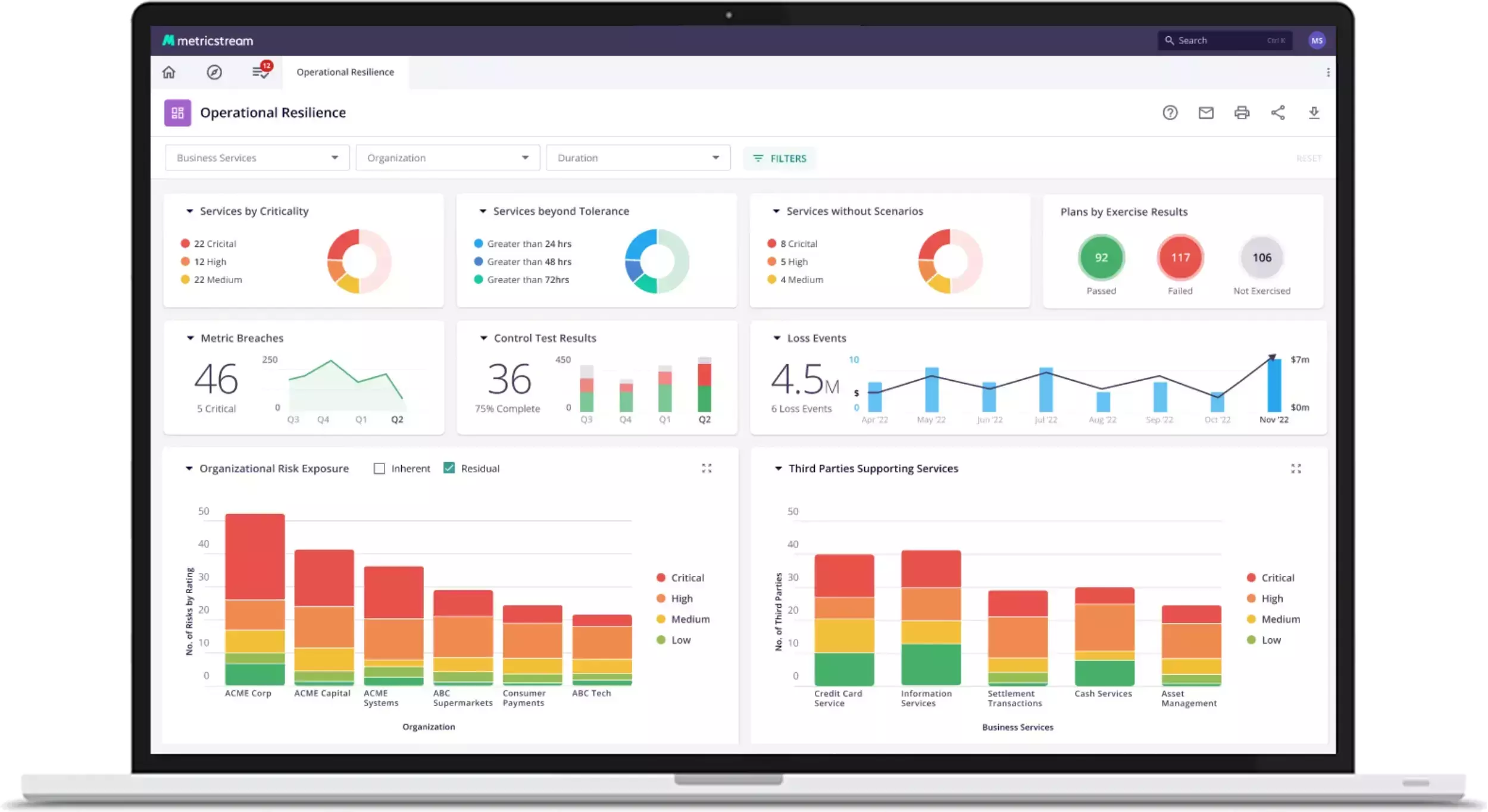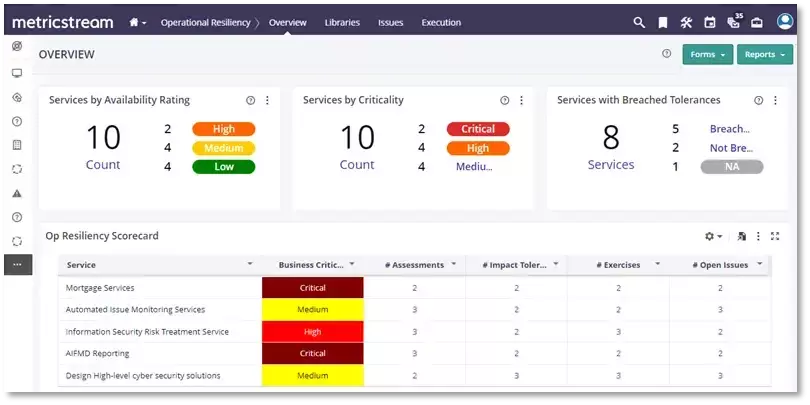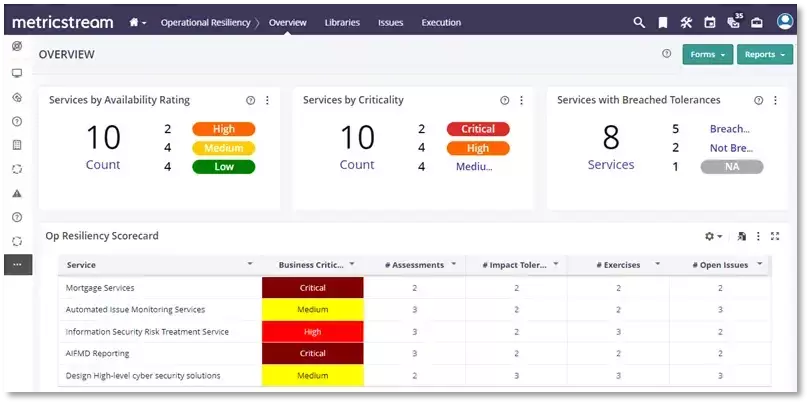Operational Resilience Management
Measure Your Program Outcomes

- 67%
improvement in risk reporting visibility and efficiency for the executive management and board

- 87%
reduction in the time taken to create and review a business impact analysis

- 80%
increase in risk and control framework-related operational efficiency


Prevent, Respond Faster, and Recover Better from Business Disruptions
The MetricStream Operational Resilience Management software enhances risk visibility across the enterprise, enabling effective mitigation and faster recovery from adverse risk events. Built on the MetricStream Platform, the operational resilience software supports today’s dynamic business needs with automated workflows, collaboration, and real-time reporting. It brings all aspects of the operational resilience framework on a single unified platform by seamlessly embedding risk management practices into your business continuity planning, allowing preparation for and speedy recovery from potential disruptions. The software gives organizations the ability to break down restrictive silos and ensure integration across various business functions while strengthening resiliency.
How Our Operational Resilience Software Helps You


Identify Critical Processes and Services, Map Dependencies
Prepare for recovery from risk events with a complete view of risk information, connections, and dependencies critical to maintaining or restoring systems, data, controls, compliance, and processes. Leverage the software’s centralized library to store and manage risks related to critical business processes, services, assets, data, applications, people, third parties, facilities, threats and vulnerabilities, and more.
Improved Risk Exposure Calculations with Impact Tolerances
Define impact tolerances, i.e. metrics that specify acceptable levels of disruption, for important business services. Continuously assess and monitor these metrics, both qualitative and quantitative, to keep them within threshold limits, identify potential threats, and mitigate them proactively.
Continuous Risk and Resilience Self-Assessments
Effortlessly plan, schedule, and perform self-assessment surveys and route the results for review and approval. Provide ratings or rankings for each business service for systematic prioritization, assess the organization's tolerance for disruptions or adverse events affecting each business service, and confirm compliance with operational resilience policies and procedures, including regulatory requirements, internal controls, and best practices.
Conduct Scenario Analysis and Testing
Identify and document plausible scenarios that can impact critical business operations. Test each of these scenarios through simulations. Record the learnings from these scenario testing exercises for further review and analysis. Refine and enhance the organization's operational resilience strategy based on these learnings, including updating response plans, improving communication protocols, and strengthening mitigation measures.
Ensure Business Continuity and Manage Crisis Better
Create, maintain, and manage continuity plans from pre-defined templates. Improve visibility by linking these plans to critical IT assets, business processes, locations, controls, and key contacts. Efficiently create and maintain emergency communications trees and distribution lists, as well as emergency notification templates across more than 25 distinct communications channels to ensure business-critical functions continue to operate.
Leverage AI-Powered Issue and Action Management
Report and manage issues and action plans triggered by risk and resilience assessments, scenario testing, and business impact analysis. Leverage AI capabilities to eliminate duplication of issues and expedite issue remediation across operational risk, cyber risk, business continuity, and third-party risk management programs. Define and track the sequence of events to ensure business recovery and program performance accountability.
How Our Operational Resilience Software Benefits You
- Strengthen business resilience with a coordinated and agile strategy for recovery from business disruptions
- Minimize redundant costs, tools, effort, and data by consolidating all risk and resilience-related data on a single, connected platform
- Enhance decision-making with contextual, real-time intelligence delivered through advanced reports and analytics
- Efficiently mitigate risks from operations, vendors, and IT infrastructure
Frequently Asked Questions
Operational resilience can be defined as an initiative that focuses on building the resilience of business activities beyond business continuity management programs. Depending on the scope, scale, velocity and severity of a risk event, a resiliency program should allow the business to adapt to and position the organization to recover as wholly as possible from a risk event.
Ideally, an organization will proactively define, agree upon, tier, and record business-critical functions required to ensure it can operate and deliver products and services to its customers. Once those needs are met, the business should further define a set of activities that can restore additional functionality, including other critical services. The how and what and order and ownership for restoring financial, human resources, cybersecurity, and facility operations is critical for businesses to continue operating.
A centralized and single operational resilience program that extends across the enterprise and into its business interdependencies is essential to crisis recovery. Operational resilience program components should not only complement a well-designed and well-run risk management program, but also include a defined set of controls, checks, events, processes, and owners all designed to accelerate and ensure the completeness of a risk event recovery.
The concept of operational resilience is not new. However, the recent health crisis, geopolitical tensions, complex extended ecosystem, rapid digitization, major cyberattacks, and environmental and social issues have brought back the focus on operational resilience.
Defining risk appetites and tolerance levels for disruption of products or services to internal and external stakeholders like employees and customers is a business-critical necessity. The essence of operational resilience is that the organization and economy can be prepared to respond better to a crisis or disruption, rather than just reacting. Ideally, organizations constantly improve assessments, controls, and recovery planning. And can demonstrate their pliability and resiliency to their stakeholders, including the public and their relevant regulators.
Recent events and operational failures have forced regulators across the globe to require organizations to implement demonstrable and defensible operational resilience frameworks. This necessitates companies to identify critical business services, set impact tolerances, consider vulnerabilities, develop appropriate mitigation actions, test, and define a consistent approach to prevent, adapt, and respond to risk events and failures.
While the regulatory focus on operational resilience is still new there are some countries starting to uphold standards with regulation. The PRA operational resilience framework in the United Kingdom, IDW PS 340 n.F. in Germany, the Digital Operational Resilience Act (DORA) in the European Union, and Technology Risk Management (TRM) guidelines by the Monetary Authority of Singapore (MAS) in Singapore have been released. In the United States, a joint paper by the Board of Governors of the Federal Reserve System, the Federal Deposit Insurance Corporation, and the Office of the Comptroller of the Currency (OCC), has been published to guide large and complex firms to address unforeseen challenges to their operational resilience. Some of the above are applicable to large and enterprise organizations across all sectors while some are specifically applicable to banking and financial services firms.
Since the start of the COVID-19 pandemic in 2020, there have been increasing regulatory measures. For instance, the digital operational resilience in the proposed Product Security and Telecommunications Infrastructure Bill in the UK will apply to individuals and businesses across the UK, and not just businesses in certain sectors.
Build your operational resilience journey and ensure your organization is well prepared to respond to future disruption by:
• Identifying and understanding the critical processes, systems, people, and third parties
• Protecting and managing risks related to them and assessing their impact on the business
• Defining and setting impact tolerances against critical risks
• Developing business continuity plans and monitoring them
• Providing actionable insights through reports and analysis
• Developing communication for key stakeholders
Operational resilience software enables organizations to successfully implement and track the success of their operational resilience strategy, strengthening their ability to anticipate, prepare for, respond to, and recover from adverse risk events.
The right software can help your operational resilience strategy by providing a single solution to meet regulatory requirements along with the tools to embed risk management practices into compliance, cybersecurity, vendor risk management, and business continuity plans to prepare for potential disruptions. Technology can support you by:
• Ensuring that all components of an operational resilience framework are easily accessible to view in a single, connected platform simplifying the tracking and managing of the risk
• Enabling data harmonization across teams, business units, and functions
• Providing automation capabilities for risk assessments, control testing, continuous control monitoring, third-party due diligence, etc.
• Ensuring a common federated taxonomy in a central risk library
• Generating powerful reporting and analytics capabilities enabling organizations to create rich analysis and derive deep insights for driving business decisions
For over 20 years MetricStream has been a leader in Governance, Risk, and Compliance (GRC), supporting businesses to take a proactive risk-based approach to compliance, cyber, and third-party risk management and enabling them to manage, co-ordinate, and track multiple GRC risks across business siloes.
MetricStream brings all aspects of the operational resilience framework into a single unified system. This allows organizations to view and track regulation across different regulatory frameworks such as PRA, IDW PS 340 n.F, and DORA. The solution seamlessly embeds risk management practices into compliance, cybersecurity, vendor risk management, and business continuity planning to prepare for and prevent potential disruptions. Through sharing best practices and key learnings with organizations, MetricStream further supports their future growth and helps build resilience strategies.
You can explore more about MetricStream Operational Resilience capabilities by downloading the MetricStream Operational Resilience Overview Sheet here. To request a demo, click here.
Also, you can visit our Learn section to dive deeper into the GRC universe and the Resources section to explore our customer stories, webinars, thought leadership, and more.













